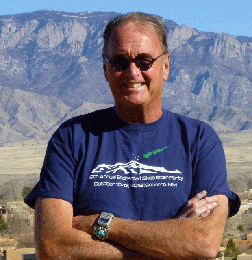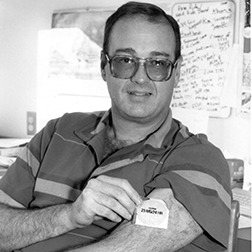
Etscorn Returns To Speak At Student Research Symposium
April 13, 2015

Standing at 6’6”, Etscorn looms large; but his gracious charm, jovial nature and down-home gregariousness make him less imposing and more approachable. Etscorn is the featured speaker at the 2015 Student Research Symposium on Thursday, April 16.
Etscorn returned to Socorro last fall to give a TECH Talk during the 49ers Celebration. He spoke at length about the discovery of the nicotine patch and his experiences at Tech. He interspersed his talk of science with humorous anecdotes, and answered questions from the crowd.
“It was great to get back,” Etscorn said. “I sneak down there every now and again to see how much it has changed and how beautiful it is. Visiting campus brings back good memories.”
Etscorn and his wife, Sheri, have two children and three grandchildren. Their son lives in San Antonio, N.M., giving them even more reason to get down to Socorro. Their daughter lives in Albuquerque.
The fourth annual Student Research Symposium at New Mexico Tech features a wide range of innovative projects, including 48 posters, 20 oral presentations and 22 three-minute talks.
The event is all day Thursday, April 16, in the Macey Center. Etscorn’s talk is open to everyone at 9 a.m. All students are encouraged to attend and learn about the interesting research students are conducting all over campus.
Etscorn’s journey in academia didn’t get off a smooth start. He flunked out of the business program at WesternKentucky University twice, then flunked out of a school in Florida as well. While he and Sheri were living in Nashville, Frank took a night course in psychology and found his calling.
“The instructor was a neurologist from Vanderbilt and he taught an intro psychology class that was physiologically and hard science based,” he said. “I decided, ‘This is what I want to do when I grow up’. I started reading psychology as fast as I could.”
Eventually, Etscorn received his bachelor's in psychology from Western Kentucky University in 1971 and his master's in experimental psychology from Western Kentucky in 1973 (later receiving a distinguished alumnus award and honorary doctorate). He earned his doctorate in experimental psychology from George Peabody College in Nashville,Tenn. He joined the faculty at New Mexico Tech in 1977 in the Psychology Department, becoming a full professor and dean of students in 1985. He received the university's Distinguished Teaching Award in 1990.
Born in Kentucky, Etscorn grew up around tobacco – in the family and on the farms. His father, Frank Jr., was a businessman, and his mother, Mary was a social worker. They also were part owners of a tobacco warehouse.
Etscorn said he worked in the tobacco warehouse but could never figure out why people enjoyed smoking. Early 'experiments' made him sick. Etscorn’s invention had a personal element. His wife, Sheri, was a smoker who struggled with quitting; his brother was also a heavy smoker. Sheri would even stop a workout video to smoke.
His quest had an accidental breakthrough. Etscorn’s entire research focus was flavor aversion. He researched how novel, harmless flavors become associated with nausea and the flavor is thereafter avoided. He was fooling around with liquid nicotine (a potent stimulant of the vomiting center) when he accidentally spilled some on his arm. Within a few minutes, he was dizzy, nauseated and unable to stand.

That incident led to more self-experimentation – as well as working with more rats in the laboratory. In one case, he was about to self-administer a 3 microliter dose of nicotine along with a transporting solvent, DMSO when undergraduate student Linda Hagan stopped him and recommended a much lower dose. In his talk, Etscorn said that advice probably prevented him from giving himself a massive overdose.
“One microliter made me sick as a dog,” he said. “We were trying to mimic the quick onset of nicotine from a smoked cigarette. She probably saved my life.”
Ever the fearless scientist, Etscorn continued to experiment on himself– and his brother. John Etscorn came to visit – on the promise that Frank would take him to the Owl Bar – and after putting a circular BandAid dosed with nicotine on his neck, John said it felt like he had just smoked a cigarette.
“That’s when I said, ‘Bazinga, this is what we want’,” said Etscorn, referencing one of his favorite TV shows, The Big Bang Theory.
Before long, he was publishing his results. By the early 1980s, he was ready to file a patent on his invention. During 49ers, he told stories about the patent process. He said he knew absolutely nothing about the patent process early on yet before the process was over there were days-long depositions about his research, the science behind the patch and his experiments.
Eventually, Etscorn and New Mexico Tech defeated a challenge on the patent from other scientists, including a group at the University of California-Los Angeles. Etscorn worked closely with patent attorney, Deborah Peacock, who later was appointed to the Board of Regents at Tech, and currently serves as the chair of the Board.
Etscorn said in his talk that three inventions were the largest selling products to come out of a university – Crest toothpaste, which was patented atIndiana University, Gatorade, patented at the University of Florida and that little ol' school in the desert's nicotine patch.
Originally known as the Habitrol patch, the patented invention was marketed by Ciga-Geigy Pharmaceuticals (now Novartis). Tech and Etscorn shared the patent and the profits, earning millions for each.
The patch was hailed as one of the best products of 1992 by Time Magazine and Fortune Magazine. Etscorn's research was featured on many TV shows, including Good Morning America, CBS News, The Today Show, ABC News, Prime Time and The Discovery Channel and in articles in The New York Times, Wall Street Journal, Time, Newsweek, U.S.News and World Report and The Chronicle of Higher Education (The Nicotine Patch Wars). The patch went over-the-counter at Kroger's, Walmart and Walgreens.
“We’ve been able to do a lot of things that we never thought we would,” he said. “I didn’t get into professor work looking for money – publish papers, research, teaching. But this whole patch thing – there’s no way to describe it. It’s been like hitting the jackpot.”
While still a professor, Etscorn served as the faculty advisor to the budding Astronomy Club. After retiring from Tech in 1993, he donated seed money to create the facility now known as the Etscorn Campus Observatory.
He and Sheri enjoy traveling a lot. After 49ers, they embarked on a 2,500 mile road trip that included a stop back in Kentucky. He said they enjoy driving up the coast of California, Oregon and Washington and going on cruises “with all the other geezers.”
They spend at least three months a year at their ranch in Wyoming, which they’ve transformed from an old ranch ranch into a wildlife refuge and beautiful slice of America.
“I take pride in that ranch,” he said. “Wyoming is beautiful – fresh air, clean water. It’s kinda cool there. But I want to be here [in New Mexico] full-time. They don’t have what we New Mexicans call chile in Wyoming.”